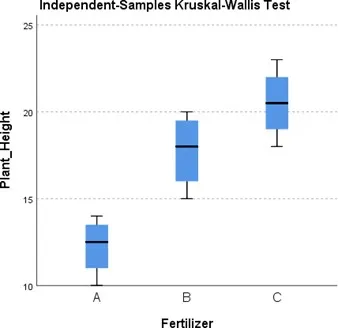Kruskal-Wallis Test Explained with Example and Use Cases

Introduction
- The Kruskal-Wallis test (H test) is a non-parametric statistical test used to compare three or more independent groups and to determine if there are statistically significant differences between them. It is an extension of the Mann-Whitney U test, which is used for comparing two groups.
- This test is an alternative of Analysis of variance(ANOVA) when the data are not normally distributed.
- It gives significant result when at least one of the samples is different from other samples.
Objectives
- To understand the Kruskal-Walli’s test and its significance.
- To apply the test to a real-world dataset.
- To interpret the results and conclude whether there are significant differences between groups.
- How to perform the test using SPSS
Theoretical Background
When to Use the Kruskal-Wallis Test
- The data is not normally distributed.
- The dependent variable is ordinal or continuous.
M1,M2…. MK are the median value of 1st and 2nd…. Kth group of samples then,
Hypotheses
- Null Hypothesis (H₀): The medians of all groups are equal. Or H₀= M1=M2=…. MK
- Alternative Hypothesis (H₁): At least one group has a different median.
Formula for Kruskal-Wallis Test Statistic (H)
The test statistic is calculated using:
H = (12 / (N(N + 1))) × Σ(Rᵢ² / nᵢ) - 3(N + 1)where:
- N = total number of observations
- <span style="font-size: 1rem;">Ri = sum of ranks for ith group</span>
- ni = number of observations in group i
The H statistic is compared to a critical value from the chi-square distribution with k−1 degrees of freedom (where k is the number of groups). If Calculated value is greater than table value we reject the null hypothesis.
Example: Effect of Fertilizers on Plant Growth
Scenario
A researcher wants to determine if different fertilizers affect plant growth. Three fertilizers (A, B, and C) are used, and plant heights (in cm) are measured after four weeks
Data Collection
| Fertilizer A | Fertilizer B | Fertilizer C |
| 10 | 15 | 18 |
| 12 | 17 | 21 |
| 14 | 19 | 23 |
| 13 | 20 | 20 |
Step 1: Rank the Data
| Value | Group | Rank |
| 10 | A | 1 |
| 12 | A | 2 |
| 13 | A | 3 |
| 14 | A | 4 |
| 15 | B | 5 |
| 17 | B | 6 |
| 18 | C | 7 |
| 19 | B | 8 |
| 20 | B | 9.5 |
| 20 | C | 9.5 |
| 21 | C | 11 |
| 23 | C | 12 |
Step 2: Compute Rank Sums
RA=1+2+3+4=10
RB=5+6+8+9.5=28.5
RC=7+9.5+11+12=39
Step 3: Compute the H Statistic
Substituting values into the formula:
H = [12 / (12 × 13)] × [(10² / 4) + (28.5² / 4) + (39.5² / 4)] - 3 × 13After calculation, <strong>H = 8.5</strong> .
Step 4: Compare with Critical Value
- Degrees of Freedom (df) = K-1 = 3-1 =2
Chi-square critical value at α = 0.05 is 5.99.
Since <strong>H = 8.5 > 5.99</strong>, we reject the null hypothesis.
Step 5: Interpretation
Since the Kruskal-Walli’s test result is significant, it means at least one fertilizer has a different effect on plant growth.
Conclusion
Significant Differences in Plant Growth Among Different Fertilizers.
References
- Kruskal, W. H., & Wallis, W. A. (1952). “Use of Ranks in One-Criterion Variance Analysis.” Journal of the American Statistical Association.
- Conover, W. J. (1999). “Practical Nonparametric Statistics.” Wiley.
- McDonald, J. H. (2014). “Handbook of Biological Statistics.” Sparky House Publishing.
Kruskal-Wallis Test in SPSS
Step 1: Enter the Data
- Open SPSS and go to Variable View.
- Create two variables:
- “Fertilizer” (Categorical: A, B, C) Measure Type: Nominal
Explanation: Fertilizer is a categorical variable (A, B, or C), meaning it represents different groups without any inherent order. - “Plant Height” (Scale: Continuous height values) Measure Type: Scale (Continuous)
Explanation: Plant height is a numeric variable with measurable values, making it a scale variable in SPSS.
- “Fertilizer” (Categorical: A, B, C) Measure Type: Nominal
Step 2: Run the Kruskal-Wallis Test
Click Analyse > Nonparametric Tests > Legacy Dialogs >Independent Samples. Fields>Move "Plant Height" to the Test Variable List>Move "Fertilizer" to the Grouping Variable>Settings>select Kruskal walli’s test>OkStep 3: Interpret the Output
| Independent-Samples Kruskal-Wallis Test Summary | |
| Total N | 12 |
| Test Statistic | 8.578a |
| Degree Of Freedom | 2 |
| Asymptotic Sig.(2-sided test) | .014 |
| a. The test statistic is adjusted for ties. | |
H = 8.5 (same as our manual calculation).
df = 2 (since we have 3 groups, df = k−1k – 1k−1).
p-value = 0.014 (which is less than 0.05, indicating statistical significance).
Box Plot (Graphical Representation)

- The box plot visually represents the distribution of plant heights across the three fertilizer groups.
- It helps in understanding the median, spread, and potential outliers.
Final Interpretation
- p-value = 0.014 < 0.05, we reject the null hypothesis.
- This means that at least one fertilizer significantly affects plant growth.
| Pairwise Comparisons of Fertilizer | |||||
| Sample 1-Sample 2 | Test Statistic | Std. Error | Std. Test Statistic | Sig. | Adj. Sig.a |
| A-B | -4.625 | 2.545 | -1.817 | .069 | .208 |
| A-C | -7.375 | 2.545 | -2.898 | .004 | .011 |
| B-C | -2.750 | 2.545 | -1.081 | .280 | .840 |
| Asymptotic significances (2-sided tests) are displayed. The significance level is .05. | |||||
| a. Significance values have been adjusted by the Bonferroni correction for multiple tests. | |||||
Interpretation of Results
- A vs. B
- p= 0.069 (unadjusted) and 0.208 (Bonferroni-adjusted).
- Since p > 0.05, there is no significant difference between Fertilizer A and B.
- A vs. C
- p = 0.004 (unadjusted) and 0.011 (Bonferroni-adjusted).
- Since p < 0.05, there is a significant difference between Fertilizer A and C.
- This suggests that Fertilizer C has a significantly different effect on plant height compared to A.
- B vs. C
- p = 0.280 (unadjusted) and 0.840 (Bonferroni-adjusted).
- Since p > 0.05, there is no significant difference between Fertilizer B and C.
Final Conclusion
- Fertilizer A and C show a statistically significant difference, indicating that one is more effective than the other in promoting plant growth.
- No significant differences are observed between A and B or between B and C.
